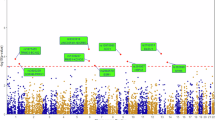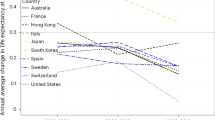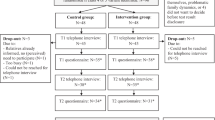Abstract
Many epidemiological studies have shown that parents, siblings and offspring of long-lived subjects have a significant survival advantage when compared with the general population. However, how much of this reported advantage is due to common genetic factors or to a shared environment remains to be resolved.
We reconstructed 202 families of nonagenarians from a population of southern Italy. To estimate the familiarity of human longevity, we compared survival data of parents and siblings of long-lived subjects to that of appropriate Italian birth cohorts. Then, to estimate the genetic component of longevity while minimizing the variability due to environment factors, we compared the survival functions of nonagenarians' siblings with those of their spouses (intrafamily control group).
We found that both parents and siblings of the probands had a significant survival advantage over their Italian birth cohort counterparts. On the other hand, although a substantial survival advantage was observed in male siblings of probands with respect to the male intrafamily control group, female siblings did not show a similar advantage. In addition, we observed that the presence of a male nonagenarians in a family significantly decreased the instant mortality rate throughout lifetime for all the siblings; in the case of a female nonagenarians such an advantage persisted only for her male siblings.
The methodological approach used here allowed us to distinguish the effects of environmental and genetic factors on human longevity. Our results suggest that genetic factors in males have a higher impact than in females on attaining longevity.
Similar content being viewed by others
Log in or create a free account to read this content
Gain free access to this article, as well as selected content from this journal and more on nature.com
or
References
Perls TT, Bubrick E, Wager CG, Vijg J, Kruglyak L : Siblings of centenarians live longer. Lancet 1998; 351: 1560.
Atzmon G, Rincon M, Rabizadeh P, Barzilai N : Biological evidence for inheritance of exceptional longevity. Mech Ageing Dev 2005; 126: 341–345.
Schoenmaker M, de Craen AJ, de Meijer PH et al: Evidence of genetic enrichment for exceptional survival using a family approach: the Leiden Longevity Study. Eur J Hum Genet 2006; 14: 79–84.
Perls TT, Wilmoth J, Levenson R et al: Life-long sustained mortality advantage of siblings of centenarians. Proc Natl Acad Sci USA 2002; 99: 8442–8447.
Gudmundsson H, Gudbjartsson DF, Frigge M, Gulcher JR, Stefansson K : Inheritance of human longevity in Iceland. Eur J Hum Genet 2000; 8: 743–749.
Kerber RA, O’Brien E, Smith KR, Cawthon RM : Familial excess longevity in Utah genealogies. J Gerontol A Biol Sci Med Sci 2001; 56: B130–B139.
Terry DF, Wilcox M, McCormick MA, Lawler E, Perls TT : Cardiovascular advantages among the offspring of centenarians. J Gerontol A Biol Sci Med Sci 2003; 58: M425–M431.
Terry DF, Wilcox MA, McCormick MA et al: Lower all-cause, cardiovascular, and cancer mortality in centenarians’ offspring. J Am Geriatr Soc 2004; 52: 2074–2076.
Willcox BJ, Willcox DC, He Q, Curb JD, Suzuki M : Siblings of Okinawan centenarians share lifelong mortality advantages. J Gerontol A Biol Sci Med Sci 2006; 61: 345–354.
Atzmon G, Schechter C, Greiner W, Davidson D, Rennert G, Barzilai N : Clinical phenotype of families with longevity. J Am Geriatr Soc 2004; 52: 274–277.
Cournil A, Legay JM, Schachter F : Evidence of sex-linked effects on the inheritance of human longevity: a population-based study in the Valserine valley (French Jura), 18–20th centuries. Proc Biol Sci 2000; 267: 1021–1025.
Herskind AM, McGue M, Holm NV, Sorensen TI, Harvald B, Vaupel JW : The heritability of human longevity: a population-based study of 2872 Danish twin pairs born 1870–1900. Hum Genet 1996; 97: 319–323.
Ljungquist B, Berg S, Lanke J, McClearn GE, Pedersen NL : The effect of genetic factors for longevity: a comparison of identical and fraternal twins in the Swedish Twin Registry. J Gerontol A Biol Sci Med Sci 1998; 53: M441–M446.
Vaupel JW, Carey JR, Christensen K et al: Biodemographic trajectories of longevity. Science 1998; 280: 855–860.
Kirkwood TB : Time of our lives. What controls the length of life? EMBO Rep 2005; 6: Spec no: S4–S8.
Yashin AI, Ukraintseva SV, De Benedictis G et al: Have the oldest old adults ever been frail in the past? A hypothesis that explains modern trends in survival. J Gerontol A Biol Sci Med Sci 2001; 56: B432–B442.
Montesanto A, Passarino G, Senatore A, Carotenuto L, De Benedictis G : Spatial analysis and surname analysis: complementary tools for shedding light on human longevity patterns. Ann Hum Genet 2008; 72: 253–260.
Poulain M, Pes GM, Grasland C et al: Identification of a geographic area characterized by extreme longevity in the Sardinia island: the AKEA study. Exp Gerontol 2004; 39: 1423–1429.
Perls T, Kohler IV, Andersen S et al: Survival of parents and siblings of supercentenarians. J Gerontol A Biol Sci Med Sci 2007; 62: 1028–1034.
Brillinger DR : The natural variability of vital rates and associated statistics. Biometrics 1986; 42: 693–734.
Elandt-Johnson RC, Johnson NL : Survival models and data analysis. Wiley: New York, 1980.
Cox DR : Regression Models and Life-Tables. J R Stat Soc Series B (Methodol) 1972; 34: 187–220.
De Rango F, Montesanto A, Berardelli M et al: To grow old in southern Italy: a comprehensive description of the old and oldest old in Calabria. Gerontology 2010, in press.
Tagarelli A, Piro A, Tagarelli G, Zinno F : Color-blindness in Calabria (Southern Italy): a north-south decreasing trend. Am J Hum Biol 2000; 12: 17–24.
Jeune B, Skytthe A, Cournil A et al: Handgrip strength among nonagenarians and centenarians in three European regions. J Gerontol A Biol Sci Med Sci 2006; 61: 707–712.
Robine JM, Paccaud F : Nonagenarians and centenarians in Switzerland, 1860–2001: a demographic analysis. J Epidemiol Community Health 2005; 59: 31–37.
Acknowledgements
The study was supported by Fondi di ateneo (ex 60%). The support of the municipalities (Bisignano, Cariati, Cosenza, Luzzi, Montalto Uffugo, Rende, and Rose) and of their officers is warmly acknowledged.
Author information
Authors and Affiliations
Corresponding author
Ethics declarations
Competing interests
The authors declare no conflict of interest.
Additional information
Supplementary Information accompanies the paper on European Journal of Human Genetics website
Supplementary information
Rights and permissions
About this article
Cite this article
Montesanto, A., Latorre, V., Giordano, M. et al. The genetic component of human longevity: analysis of the survival advantage of parents and siblings of Italian nonagenarians. Eur J Hum Genet 19, 882–886 (2011). https://doi.org/10.1038/ejhg.2011.40
Received:
Revised:
Accepted:
Published:
Issue date:
DOI: https://doi.org/10.1038/ejhg.2011.40
Keywords
This article is cited by
-
Longevity defined as top 10% survivors and beyond is transmitted as a quantitative genetic trait
Nature Communications (2019)
-
Human longevity: Genetics or Lifestyle? It takes two to tango
Immunity & Ageing (2016)
-
Human longevity and variation in DNA damage response and repair: study of the contribution of sub-processes using competitive gene-set analysis
European Journal of Human Genetics (2014)
-
MAP3K7 and GSTZ1 are associated with human longevity: a two-stage case–control study using a multilocus genotyping
AGE (2013)
-
Epidemiological, genetic and epigenetic aspects of the research on healthy ageing and longevity
Immunity & Ageing (2012)



